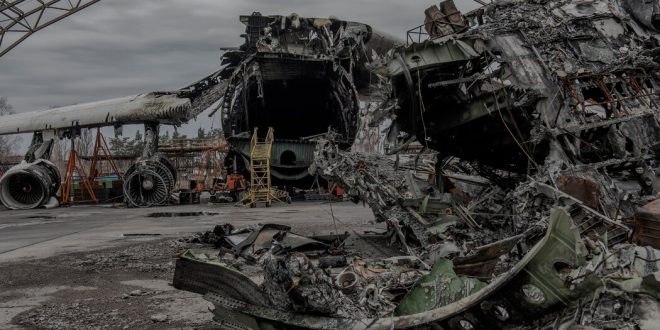HOSTOMEL, Ukraine — The gigantic twin tail fins, once stretching as high as a six-story building, are gone.
So are the tailplane, flaps, hydraulic systems, fuel pumps and three of six engines of the plane, which was destroyed in fighting in the first days of the war.
Piece by piece, workers are now dismantling the wreckage of the gigantic Mriya cargo plane, the heaviest airplane ever flown, with plans to rebuild a new one with salvaged parts. The restoration of the plane, whose name in Ukrainian means The Dream, has begun.
With the war still raging, the immense job of rebuilding Ukraine, where hundreds of thousands of homes, hospitals, schools and bridges are blown up, still seems a distant prospect. Measured against those daunting challenges, the work on the plane is hardly a top priority from a humanitarian point of view. But it is meant in part as an inspiration, according to executives at the aircraft company that owns it, Antonov.
If something as gargantuan and complex as this airplane can be restored, they say, so can the rest of the country.
“People should have hope,” said Vladyslav Valsyk, deputy director and chief engineer of Antonov, a state-owned company. “They have to know this plane is not abandoned. Yes, there is a lot of work to do, but we are working.”
But critics say that devoting money and energy to rebuilding the plane would be a misplaced priority.
Valery Romanenko, an aviation analyst, has said to Ukrainian media that Antonov should focus only on “doing something urgent for the armed forces” during the war, such as making drones. “There are just no words,” he said of the plan to rebuild the Mriya.
President Volodymyr Zelensky announced last May that Ukraine would rebuild the Mriya, the only one of its kind ever completed. Over the summer, the British entrepreneur and aviation enthusiast Richard Branson visited the wreckage and expressed excitement about helping in its restoration, when the time came.
The company last week announced the start of the salvage operation and design work but said piecing together the new craft will wait until after the war.
Workers are unbolting what they can from the soot-smeared wreckage and engineers are drafting plans to use these rescued parts, along with spare parts, engines from a similar aircraft and a long-mothballed extra fuselage — to build a new airplane, company executive say. Rebuilding is expected to cost about $500 million, and financing has yet to be lined up.
But the company said the lengthy lead time to get the plane in the air again means it cannot wait to begin planning and collecting parts. Antonov said it is in talks with European, American and Asian aviation companies, and with potential customers for future cargo flights.
The plane, built in Kyiv in the 1980s and extensively overhauled after the country won independence from the Soviet Union, has long been Ukraine’s pride. Designated AN-225, it was bigger than any other in the sky, with a wingspan of 290 feet and a maximum takeoff weight of a staggering 1.4 million pounds.
It was made to carry the Buran, the orbiter in the short-lived Soviet space shuttle program. Later, its bulbous, almost cartoonishly rotund body carried unwieldy industrial objects like wind turbine blades or locomotives, and pleased crowds at air shows.
Even as the first steps toward the plane’s restoration are taken, police are investigating the circumstances of its destruction.
The evening before Russia invaded, a crew had the plane prepared to fly to safety outside Ukraine, Maksym Sanotskyi, the company’s deputy director for transport, said in an interview. Takeoff was scheduled for the following afternoon. But time ran out.
Russian troops crossed the border in the pre-dawn and Russian special forces swooped into the Hostomel airport, the base for the Mriya, with a helicopter assault. In the ensuing battles over the airport, located just outside Kyiv, the plane was sprayed with shrapnel and caught fire.
Last week, alongside the company’s announcement of progress on restoring the craft, police announced the arrest of several former executives of the Antonov company on suspicion of obstructing the work of the military in securing the Hostomel airport in the days before the invasion.
In a statement, prosecutors said the company had not allowed the Ukrainian National Guard to build defensive positions at the airport, for reasons that remain unclear, leading to the destruction of the Mriya. Mr. Valsyk, the deputy director, said he could not comment on the investigation.
The airplane, of course, is not at the top of Ukraine’s long list of priorities for rebuilding after a year of the most destructive war in Europe since World War II. Hardly a city is left untouched by missile or artillery strikes, and millions of Ukrainians are displaced or living in towns without running water or electricity.
Antonov says the airplane has commercial potential — when it is chartered by companies in the energy industry, for example, to haul huge pieces of equipment around the world, the hourly cost is about $32,000. The company also said the plane is priceless as a symbol of Ukraine.
But a former engineer at Antonov, Anatoly Vovnyanko, has told Ukrainian media he doesn’t believe the company will ever recoup its outlays through commercial charters. “No one needs it, this Mriya,” Mr. Vovnyanko said. “The money will never be recovered.”
Even the plane’s main appeal, its gigantism, has drawn criticism as a holdover of Soviet mentality that Ukraine has no need for today.
The Soviets built “the world’s largest locomotive, bulldozer, sugar factory, iron smelter” and so on, one critic, Serhiy Marchenko, wrote on Facebook. “All these greatest things have one thing in common: senselessness.”
He called the public relations efforts around the restoration an affront to people who lost their homes in the war.
Many challenges remain. While the Mriya shares parts in common with another, Ukrainian-made cargo plane, the Ruslan, some parts will have to be custom made. Half a dozen Ruslan planes are still flying from a base in Germany.
On the positive side, the company has a complete fuselage for a Mriya plane in storage, left over from an abandoned plan to build a second cargo giant. Salvaged and new parts can be fitted to this fuselage.
So far, three of six jet engines, flaps, parts of the hydraulic systems, some of the landing gear and fuel pumps and the tail assembly have been salvaged, said Mr. Sanotskyi. Certifying the new plane as airworthy with European and American regulators will be a challenge, he conceded.
Valentyn Kostiyanov, 68, a technician who worked on the Mriya when it was built in the 1980s, was examining the tangles of wires and hydraulic lines deep inside the wreckage one day last week, searching for possibly flight-worthy parts.
“It was burned so cruelly,” he said.
The plane, now propped up on jacks, creeks in the wind and strips of insulation flutter from holes in the fuselage. Wires dangle from the wings. “So much time we put into it, thousands of hours, for years we were building it,” Mr. Kostiyanov said, only to see it destroyed in the Russian invasion.
He has no second thoughts about the decision to try to make the plane fit for flying again.
“Ask anyone in Ukraine,” he said. Even a “two-year-old child will tell you to rebuild the Mriya.”
Maria Varenikova contributed reporting from Hostomel, Ukraine, and Jeffrey Gettleman from London.
 Top Naija News – daily news updates in Nigeria | breaking news naija Welcome to Top Naija News, your ultimate destination for daily news updates in Nigeria. We are a dedicated news curation blog from various sources.
Top Naija News – daily news updates in Nigeria | breaking news naija Welcome to Top Naija News, your ultimate destination for daily news updates in Nigeria. We are a dedicated news curation blog from various sources.




